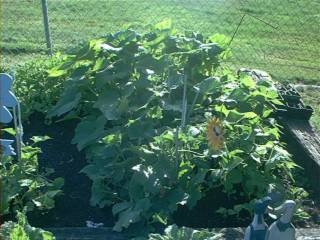Zones, Planting Seasons,Calendar In the Sunset Western Garden Book (1996, 2001, Sunset Pub. Corp., Menlo Park, Calif.), the western U.S. is divided into 24 Climate Zones. These Climate Zones do NOT correspond to the USDA Hardiness Zones.
Zone 5Marine Influence Along the Northwest Coast Mild ocean air bring relatively warm winters in this Zone. Minimum temperatures range from 28o to 1o F, although in some year a "big freeze" can cause considerable damage to plants. Zone 5 extends from the Puget Sound area in Washington, including Seattle and Tacoma, south along the Pacific Coast to north of Brookings, Oregon, including Astoria, Newport, Coos Bay.
Perennials * Delphinium - twice over the years and both eaten by slugs
* Asiatic Lillies -transplanted and they died
* Calla Lilly - grrr, of 5 planted, only one has come back
* Daisies - tall variety, transplanted, doing well
* Carnation - doing well
* Snapdragon - does well
* pansies - does well
* dusty miller - does well
* iris - does quite well
* gladiolas - doing well
* calendula orange flowers - not perennials, but have blooms into winter
* primroses - does well
* ranunculous flowers, red, yellow, white - slugs ate them
* heliotrope - not perennial, an annual, and nice choice
* tulips - after 3 yrs, looks like tulips bloomed this year
* daffodils - does well
* Columbine - volunteered in 2005 and doing well in 2006.
* Foxglove - didn't come back, trying again this year with new plant.
* Creeping Buttercups - arghh, like weeds, bane of my garden beds.
* Lavender - many varieties
* Rosemary - evergreen actually, and grows to bush size
* sedum varieties
* Hibiscus - 2 plants 2006, planted front rose bed
* Bleeding Heart - white; planted 2006, shaded back side of yard.
* Dahlia - 2 plants 2005; died.
Annuals * pansies - does well
* petunias - does well
* cosmos - does well
* sunflowers - slugs eat, russian mammoth spectacle if can keep slugs from it
* marigolds - does well
* strawflowers - does well
* geraniums - does well
* allysum - does well
* baby's breath .. white flowers
* begonias - does well
Bulbs and Rhizones * iris - doing great
* calla lillies - finicky
* asian lillies - died
* easter lillies - died
* gladiolas - doing well
* hosta - 4 plants disappeared,slugs or died
* hosta type in planters
* tulips..lost them, didn't produce again. oops reappeared in 3rd yr
Trees * Harry Lauder Walking Stick Tree
* Monkey Puzzle Tree
* Maple
* Weeping Norway Spruce
* Evergreen trees in back yard
* 10 dry root seedlings Natl Arbor membership - which in 4th yr are showing progress. Next spring if they flower, I can perhaps identify which is which. We lost the coloring chart. 3 in front yard, 2 in back yard so 5 of 10 of the tree roots made it.
* Mugho pines - planted 2 small starters this yr = 2006
* Japanese white flowering Mt Fuji - planted 2006
* Apple hybrid tree with 3 apple varieties on one tree - planted 2006. (will list varieties here)
* Eucalyptus - 2 trees. planted one in front yard 2006 and one in whiskey barrel planter end of 2005 season.
Shrubs and Bushes * Rhodedendrons = Eight mature.
* barberry, a small tree or shrub w vivid yellow blossoms and red berries. Oh, why - husband pulled up when we were ignorant of what it was - total loss in trying to re-plant or propagage. Good news though, in the other bed, a shoot is coming up, so may still have a new barberry with it's internal yellow trunk - medicinal properties.
* Hydrangea = 3, and only 1 lived, 2004. It is doing well in it's third year
* Lilac = mature, but it is struggling. Lost 2 trunks in Fall 2005, new baby is coming up between remaining 2 trunks.
* Fuschia Tree - does very well, cautiosuly pruned in spring 2005, no need as it comes back in fullness. hard pruned spring 2006 and it still comes back in fullness.
* juniper - mature, tried to propagate 2006; not taking
* Weeping Norway Spruce - doing well
* Lacey Leaf Japanese Red Maple, not dwarf - 2004. slow growing and doing well
* Forsythia - 2005, and doing well in 2006.
* Eastern snowball - 2006, newly planted, we'll see how it does
* Mallow tree - 2006. perennial, delicate pink flowers on elongated stems.
Herbs
* Lavendar = 11
* Rosemary = 3
* Oregano = 3
* Sage = 2
* Basil - annual
* Marjoram - didn't make it
* new herb, need name, haven't used before
* Parsley - annual
* Chives - doing well
* Mint - planted in ground 2006
* Catnip - excellent for perennial w/ purple flowers
* Salt and Spice herb - annual
* Tarragon - 2006 not doing well
* Thyme - have planted from nursery twice, died both times 2005, 2006.
Rock Garden Planted rock garden in 2004. In it's third year in 2006, it is looking very nice.
* Sedums, will try to list names of varieties.
- candy tuft = white flowers
- autumn joy = rust color tops in Autumn
- usual array, names not known.
* Lavender - three varieties. Cotton lavender is magnificent as it sprawls and crawls all over the rocks.
* Dracenia - from a small plant to a spectacular centerpiece - sharp and pointed up growing stems.
* Forthsythia - bush, I know, and probably not best at rock garden, but I love to see that first yellow of spring from kitchen window. Planted 2005.
2006, extended the beds in rock garden area as adding additional plants.
* poker plant
* achillibe
* coral bells or lily of the valley
* elephant ears plant (bulb)
* ground cover (purple flower - need name)
* another lavender plant
* rock garden evergreen - yellow flowers (need name)
* rock rose - pink flowers
* iris bulbs (transplants, likely won't leave in this bed)
* perennial white flowers (need name)
* autumn joy sedum
* upright blue flowering perennial (know name, can't recall - need)
* delphinium - slugs ate
Vegetable Garden2004 * Radishes (Good)
* Lettuce (Good)
* Spinach (Good, but won't grow it again)
* Onions (Good)
* Tomatoes (Great)
* Corn (Good)
* Zucchini Squash (Great)
* Summer Squash (Great)
* Acorn and Winter Squash (Great)
* Pumpkins (Great)
* Cucumbers (Great)
* Cauliflower (way too big a plant, won't grow it again)
* Wax beans (Great)
* Eggplant (didn't grow, season too short?)
* Watermelon (didn't grow, season too short or not hot enough?)
* Green Peppers (Great)
2005
Same as above with new additions;
* Beets
* Turnips
* Snap Peas
* Green Beans
* Elephant Garlic
* Carrots
* Lima Beans
* Elephant Garlic
2006Same as previous years but miserable failure of entire garden this year.
- Elephant garlic did well in it's 2nd yr.
- beets growing large and well.
- radishes growing well as usual.
- tomato plant from nursery producing
- all else failed this year, slugs ate the tender plants. twice planted zucchini, squash, cucumbers and slugs got every one. Also neighbor gave me well rooted zucchini and cucumbers and slugs got those also..
- new challenge and problem; combatting slugs! I have been reluctant to kill slugs in previous years, but with the end of last season and this season (2006), I can't afford to be so merciful.
- new challenge; the borage/comfrey I planted from seed in 2004 came back again in 2005, but in 2006 it was popping up all over the actual vegetable garden space and in rock garden bed. Researching it, seems it has that characteristic, has some underground growing mechanism, and is next to impossible to entirely get rid of once it starts that system. Groan -- been trying to rid of the perpetual creeping buttercup and creeping morning glory and wound up planting another permanent creeper. Had I known, never would have planted. What have I wrought with one package of seeds?!
Berries * Strawberries = 6 in 2004; 3 lived, bought 3 more 2005; doing well in 2006 although so far few to no strawberries. Time to transplant to more permanent space.
Compost and Fertilizer * kitchen compost, scraps
* purchased bags compost
* Used Sam's last year 2004. Miracle Gro this year 2005. None 2006.
* Using purchased top soil both years, split bag one year; garden space this year.
Seeds and Preserving Seeds * Sunflowers
* Green Pepper
* Cucumber
* Zucchini
(great, but I've misplaced and can't locate the preserved seed packets in 2006)
Roses * 1 miniature in 2004 w/ red, pink, coral roses on one bush
* 3 packaged root climbing roses 2004, 1 yellow Peace Rose, 1 traditional climber with small pink roses and 1 hasn't bloomed yet so don't remember it's rose color yet. It bloomed, and is a deep burgundy.
* Bought 3 more packaged root rose bushes 2005; planted in front bed, 2 lived = pink buds and yellow buds but coral buds died.
* Bought another root rose 2006 for front bed; it's struggling.
* Bought climber, yellow, to plant in raised railroad tie bed as permanent anchor. Now have permanent hydrangea, permanent climbing rose, permanent catmint, permanent yarrow. And permanent lavender in the brick post column.
Indoor Plants * Spider plants
* Jade plant
* Rattail cactus (died)
* Flowering cactus
* Philodendrom
* Scheffelaria (bush size now, 5 yrs old)
Propagating * Harry Lauder Walking Stick Tree = 3, already 2 died, premature cutting away from mother
* Spider plants
* Yarrow, volunteers from seed blowing
* 2006, tried again, most all failed. Cotton lavender may have taken; pussy willow tree (my Mother's yard) may taken, cedar shrub may have taken.
Garden journal at Dave's Garden and also at Wee Garden website.
Decorating Yard n Garden * old shoes, planter
* storebought stakes w/ ornaments
* decorative trellis = 2
* windchimes
* swirls
* stepping stones
* yard sales/flea market items as bowls, urns, baskets, old garden gloves
Weeds and Pests Arghh on the Slugs! Also the creeping buttercups.
entry by Lietta Ruger 








